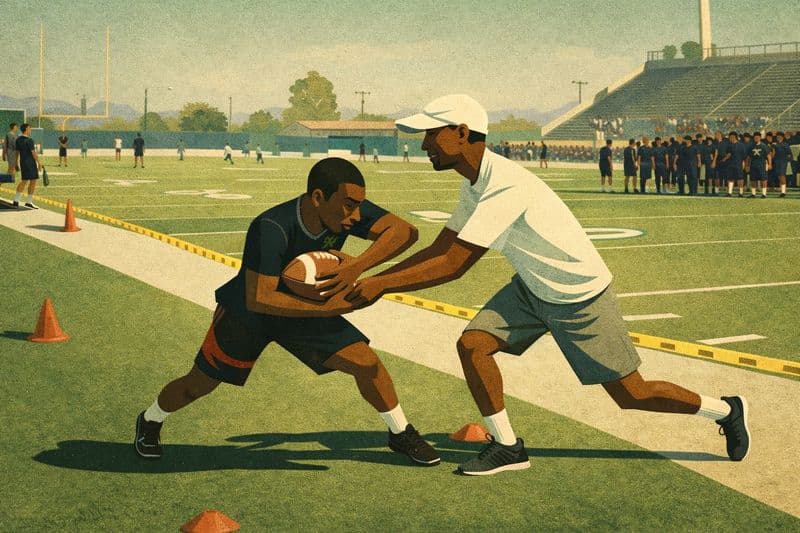While getting better at tennis doesn’t happen overnight, with dedication, practice, and a sprinkle of strategic know-how, you can significantly improve your game in no time.
Whether you've been hitting tennis balls against your garage door or dreaming about Wimbledon, we've got some tips to improve your tennis game.
Learning The Rules of Tennis
Understanding the rules of tennis is like having a roadmap; you'll know where you're going and how to get there without accidentally driving into the lake.
Read up or watch videos: Dive into the rulebook or find some fun and engaging tutorial videos online. You'll discover not just the hows but the whys behind each rule.
Watch matches: Pay attention to professional matches. It's like a free lesson in what to do (and sometimes what not to do).
Play with a buddy who knows: Nothing beats on-court learning. Find a friend who's patient and knowledgeable to guide you through the nuances of the game.
Take a beginner’s tennis lesson: A professional tennis coach can break down the fundamentals, provide personalized feedback, and help you establish a strong foundation for your tennis journey. Plus, you'll meet other players at your skill level, creating a supportive and motivating environment for learning and improvement. Find a coach near you.
Check out this player’s tennis rules guide.
Breaking Down The Fundamentals
Mastering the fundamentals is like building a strong foundation for your house; without it, things might crumble when the wind picks up (or when your opponent starts serving rockets).
Grip it right: Your racket is an extension of your arm. Experiment with different grips for different shots and find what feels natural and effective.
Positioning is key: Learn the art of positioning yourself optimally on the court. It's about being in the right place at the right time, which surprisingly is not at the concession stand.
Footwork & Movement Tips
Dancing on the court isn't just for victory celebrations. Your feet are your best friends in tennis, so treat them well. Take short, quick steps, and practice drills that improve your balance.
Basic Strokes to Master
Every artist starts with basic strokes, and in tennis, you're painting with your racket. Here are the strokes to turn you into the Picasso of the court.
The forehand: It's your bread and butter. Practice hitting with topspin, flat, and slice to keep your opponent guessing.
The backhand: Whether it's one-handed or two, your backhand can become a weapon. Don't neglect it just because it's on the "other side."
The serve: The only time in the game you have complete control. Use it wisely. Experiment with different types of serves to find your ace.
The volley: Perfect your net game by practicing crisp volleys. It's about touch, not power, like whispering sweet nothings to the ball.
The smash: When the ball looms overhead, unleash your inner Thor. Practice makes perfect, and smashing can feel oh-so-satisfying.
Advanced Stroke Techniques
Once you've got the basics down pat, it's time to add some flair and unpredictability to your game. Advanced stroke techniques can turn a standard rally into a showcase of skill and strategy.
Topspin lob: Perfect for when your opponent is too close to the net.
Slice serve: Add some side-spin to your serve to make the ball slide away from your opponent, leaving them grasping at air.
Drop shot: The art of softly tapping the ball just over the net, making your opponent sprint like they're catching a bus.
Popular Gameplay Strategies
Knowing how to hit the ball is one thing, but knowing how to win points consistently requires strategy. Here are some gameplay strategies used by the pros.
Serve and volley: An aggressive play that involves moving forward to volley right after serving.
Baseline play: Keeping to the baseline and using powerful groundstrokes to dominate play.
Counter-puncher: This strategy involves using your opponent's pace against them.
Tennis Equipment Tips
Your gear can have a significant impact on your game. Here are a few tips to ensure you're well-equipped for victory.
Racket matters: Find a racket that complements your style of play. It should feel like an extension of your arm, not a foreign object. Learn more about how to find the perfect racket.
String tension: The right string tension can add power or control to your shots. It's like tuning a guitar; find the right pitch that sings to you.
Comfortable footwear: Never underestimate the power of comfortable shoes. They can be the difference between reaching that shot or just missing it.
Proper Etiquette & Sportsmanship
Tennis is not just about winning; it's about how you play the game. Proper etiquette and sportsmanship are essential.
Acknowledge good shots: If your opponent makes a great shot, acknowledge it. It shows respect and class.
Keep your cool: Everyone gets frustrated, but throwing a racket or arguing loudly is a no-go. Breathe and focus on the next point.
Be honest: If a ball was in and you saw it, don't call it out. Integrity in tennis is more valuable than any single point.
The Mental Side of Tennis
Tennis is not just a physical game; it's a chess match, where mental toughness can make or break a player. Mastering the mental side of tennis is about playing the game within the game.
Stay present: Focus on the here and now, not the last point you lost or the final game you need to win.
Manage your emotions: Learn to keep a cool head. Whether you're up or down, keeping your emotions in check can help you stay focused on your strategy.
Visualize success: Picture your shots landing perfectly before the match. Visualization is a powerful tool for confidence and focus.
Playing Tennis Outdoors vs. Indoors
The environment in which you play tennis can significantly affect your game. Understanding the nuances of playing outdoors versus indoors will help you adapt and excel in any setting.
Wind and weather: Outdoors, you'll contend with the elements, like wind, which can turn a simple shot into a complex calculation.
Surface variations: Indoor courts typically offer a consistent surface, while outdoor courts can vary from grass to clay to hard court, each requiring different tactics.
Lighting conditions: Indoor lighting is consistent, while outdoor play means dealing with changing light and shadows, which can impact visibility.
Competing Against Different Skill Levels
Facing opponents of varying skill levels can be challenging but also presents a unique opportunity for growth.
Higher skill levels: Playing against more advanced players can highlight areas for improvement and push you to raise your game.
Lower skill levels: Competing against less experienced players allows you to work on specific aspects of your game, like consistency or a new stroke, in a less pressured environment.
Each opponent is different. Learning to adapt your strategy on the fly is a valuable skill, teaching you to read the game and adjust accordingly.
Outside-the-Box & Lesser Known Drills
To keep your training fresh and challenging, incorporating some unconventional drills can enhance your skills in ways traditional practices cannot.
- Tennis ball machine with a twist: Use your tennis ball machine, but aim for targets placed at various locations on the court to improve accuracy under different scenarios.
- Practice with a heavier racket: Training with a slightly heavier racket than you compete with can improve your arm strength and racket head speed.
- Blindfolded balance drill: Practice balancing on one foot with your eyes closed to improve your proprioception (sense of body position), crucial for maintaining balance and coordination on the court.
Remember, improving your tennis game is a journey, not a sprint. Enjoy each step, laugh at your mistakes, and celebrate your victories, no matter how small. Now that you’re equipped with these tips to improve your tennis game, you'll not only get better at tennis fast, but you'll have a blast doing it.
So, what are you waiting for? Take your first tennis lesson today by finding a top coach near you.



